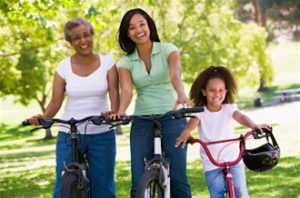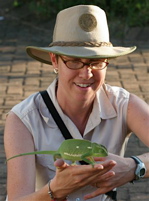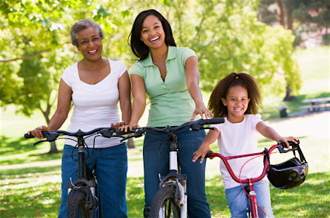 You may have heard the phrase, “the family that prays together, stays together.” It is true. Prayer is the spiritual exercise that we do daily to keep our relationship with God and each other healthy. But, there is also a need to keep our physical bodies healthy too. Families that exercise together make healthy choices, live healthier lives and are more connected with each other. A family based approach to health and wellness improves physical health and leads to maintaining healthy behaviors through the seven family stages: new couples, maternity, early childhood, childhood, teenage, college and expanded multi-generational (Gruber & Haldeman, 2009). The family unit plays an integral part in not only good spiritual health, but physical health as well.
You may have heard the phrase, “the family that prays together, stays together.” It is true. Prayer is the spiritual exercise that we do daily to keep our relationship with God and each other healthy. But, there is also a need to keep our physical bodies healthy too. Families that exercise together make healthy choices, live healthier lives and are more connected with each other. A family based approach to health and wellness improves physical health and leads to maintaining healthy behaviors through the seven family stages: new couples, maternity, early childhood, childhood, teenage, college and expanded multi-generational (Gruber & Haldeman, 2009). The family unit plays an integral part in not only good spiritual health, but physical health as well.
These seven stages comprise the full cycle through which a family goes. Along with the description of each phase I have included some personal statements from individuals in each of the stages to illustrate how healthy behaviors are incorporated into their daily routines
.
 STAGE 1: A COUPLE PRIOR TO HAVING CHILDREN
STAGE 1: A COUPLE PRIOR TO HAVING CHILDREN
This is probably the easiest stage for individuals to choose a healthy lifestyle. It is in this stage where couples may have more opportunity to exercise and spend more money on healthy foods. It is this stage where couples believe that, “we are young and ready for the journey of married life!” There is excitement and joy as the couple establishes their daily routines together, which hopefully includes healthy behaviors. Some of the couples I interviewed said, “exercise and eating healthy is easy because we do it together and hold each other accountable,” “exercise is always tough, but we as a couple have decided that in order for us to stay healthy we need to hold each other accountable, we also want to be healthy when we decide to have children.” Another couple reported that prior to getting married they exercised individually on a regular basis. Now married, they actually still prefer to work out individually. Of the individuals I talked to, they all agreed that as a couple it was important to understand their partners desire to be healthy and to support their efforts.
This is a critical step in establishing healthy behaviors throughout their marriage and throughout the various stages of a family. Exercise habits established as a couple early on in the marriage can help couples more fully realize God’s true purpose in “marriage” where two people become one.
 STAGE 2: MATERNITY STAGE
STAGE 2: MATERNITY STAGE
The maternity stage is an exciting time for families! Mom and dad are anticipating being proud parents and looking forward to the new addition. Some people believe that exercise during this stage may not be a good thing. However, according to Hatch et al. (1993) the babies who were born to mothers that exercised at a low-moderate intensity had a higher birth weight than those who were born to mothers who did not exercise during the pregnancy. From personal interviews, individuals have indicated that, “exercise during my pregnancy helped me maintain an appropriate weight, and also increased abdominal muscle strength which reduced back pain.” Others indicated that during the pregnancy “exercise was an integral part of my daily life because it just made me feel so much better!” Still another mom stated that, “I was probably healthier during my pregnancy, because I wanted to be healthy for the baby.” These moms all agree that exercise helped them during their pregnancy and that they would most likely exercise during their pregnancy if they were to have another baby. Recognizing, as the Bible says, that the body is a dwelling place for the Holy Spirit only serves to reinforce the idea that expectant mothers should protect and nurture a healthy body for their growing infant.
 STAGE 3: BABY TO TODDLER TO KINDERGARTEN STAGE
STAGE 3: BABY TO TODDLER TO KINDERGARTEN STAGE
This time in life is often called “the great adjustment”…..at least for new parents. Long gone are the days of spontaneity. They are replaced with the days of schedules, routines and get it done …..sometime this week! It takes a lot of effort and hard work to make healthy choices during this stage, however, the good news is that it CAN be done! One couple I interviewed had some good suggestions, “We started early with our little ones. From the beginning we introduced them to natural fruits and veggies and grains as a daily part of their routine. So much so that now they eat things that even I have a hard time stomaching (ie:prunes) with delight. They get the occasional pancake (generally Saturday mornings) or other such thing. But hopefully we are training them to have those things in moderation. Not necessarily forbidden, just measured.”
They also said that yoga is part of the routine for everyone in the family and that all participate. This family also reported that they have at least four soccer balls laying around the house which are often played with throughout the day. One suggestion that was made by this couple was to take the kids on “adventure walks”. On their adventure walks they go about three miles “discovering” the environment. It is a great way to keep the kids minds off the idea of exercise yet at the same time making it a habit. Not only did these walks allow the kids to discover the environment but it allowed the parents a natural opportunity to discuss God’s creation.
Another critical part of this family’s routine was the limitation of TV time. The kids are limited on the amount of time they can watch TV and are then required to think “outside the box” for activities. Another tip or suggestion from this family was to get a pet. Yes, they can be added work, but they can contribute to the exercise of the family. In fact, research indicates that families with pets exercise more than those who do not have pets (Serpell, 1991). So although this is a tough stage to keep those healthy habits, it CAN be done! Hang in there, establish a routine and keep on track!
 STAGE 4: CHILDHOOD TO PRE-TEEN
STAGE 4: CHILDHOOD TO PRE-TEEN
According to Crockett (1987) exercise and eating habits are formed during early childhood and adolescents and once established are difficult to change. Therefore it is imperative that healthy choices are made during these early developmental stages. Furthermore, it is during this stage that children are more amenable to change, however this change needs to come from parental guidance (Crockett, 1987, Proverbs 22:6) Families that have children during this stage have reported that this is a difficult stage due to time. Most families I talked to indicated that it was during this stage that their kids were introduced to organized sport. Organized sport was a great way to get the kids away from the TV/video games and into activities that not only required physical activity, but also required them to work together with other individuals. Some of the families indicated that this also allowed them to have teachable moments with their kids, specifically as they (the kids) began to realize that that there are some kids who are better and perhaps not as good as them physically. So although this stage can be challenging, it is important to begin establishing the exercise routines as a family so that it becomes a habit.
 STAGE 5: TEENAGE YEARS
STAGE 5: TEENAGE YEARS
The teen years are a time of guided independence. It is a time where parents hope that their years spent teaching the child have had an effect. The trying moments during this transition time to independence often leave parents wondering. Teenagers are learning who they are while at the same time testing the boundaries. One couple reported that persistence was their greatest friend! Although their teenager longed for independence they reminded them of the importance of family time.
Family time during this stage includes exercise! In particular, dad would work out and do outdoor activities with son allowing them to develop a stronger relationship. The parent/child relationship during these teen years is imperative for a healthy family not only physically but spiritually. One family reported that the teenage son was encouraged to help the younger kids get active by playing games with them. Persistence was the key word as they did not always see eye to eye on the activities.
Another family reported that during the teenage years the parents were able to help their children develop better skills in specific sports by spending time with them practicing. This got both the teenager and the parents outside and active. Although the teenage years can be challenging it is important to keep working toward the goal of an active lifestyle, be it through community, school or church activities.
 STAGE 6: YOUNG ADULTS (COLLEGE AGED)
STAGE 6: YOUNG ADULTS (COLLEGE AGED)
For most young people going off to college is either exciting or scary. The college campus has many obstacles that have to be overcome, particularly the dreaded “Freshman 15”. The Freshman 15 are the additional 15 pounds of weight often gained during the first year of college. So what is the college students approach to exercise? Most college students I spoke to indicated that the first year was the toughest because there were so many new things to learn and to get involved with that it detracted from the idea of having a specific time to exercise. However, the longer they were in college the more they realized the importance of exercise not only to improve their health, maintain a healthy weight, and feel good, but also as a means to “de-stress”. God’s plan is for everyone to live life abundantly and joyfully. Using exercise to “de-stress” can allow college students to maintain focus and stay healthy.
College students indicated that intramurals played a big part in them staying active allowing them to get and stay connected with friends. Intramurals allows students to form relationships, and relationships are a key component of living a God-focused life. College students with active health-minded parents are comfortable building connections between their friends and parents.
 STAGE 7: EXPANDED FAMILY – ONCE THE GRANDCHILDREN ARRIVE
STAGE 7: EXPANDED FAMILY – ONCE THE GRANDCHILDREN ARRIVE
The golden years should be a time that affords adults more opportunities for relaxation. This relaxation can mean incorporating exercise into the daily routine. Most of us have had grandparents who were active in their older age, doing things such as walking the dog, weeding the yard or just playing with the grand kids. This is a wonderful opportunity to continue their healthy habits, while at the same time serve as a role model for a younger generation. I remember meeting a wonderful Christian woman who was in her late 50’s who participated and taught several yoga and pilates classes, particularly for the elderly population. I was amazed at her flexibility. I wasn’t even close to 50 and barely able to touch my toes. She inspired me to begin a yoga class so that I too can hopefully inspire a younger person to be active.
Active at an older age is also important in order to keep strength. Most of the grandparents with whom I spoke wanted to be healthy in order to play with their grandchildren. Being older does not bring the end exercise, in fact it should be emphasized more in order to stay strong through the golden years.
START TODAY AND DO IT FOR THE REST OF YOUR LIFE
Exercise and healthy behaviors support family members at various stages to not only improve their health but also stay connected with one another. Exercise helps family members to set goals together, share in accomplishments and hold one another accountable. The family unit should be treasured and strengthened both spiritually AND physically. Exercise, healthy eating and recreation are effective ways for a family to stay connected and mature through life together. Maintaining a lifelong commitment to physical fitness will undergird the spiritual health of your family.
So adopt a new phrase in your household, “the family that prays together, plays together!”
 Lindsay Edwards, Ph.D is the assistant professor of fitness and sport sciences at Hardin-Simmons University. She was born and raised in Germiston, South Africa. She attended Abilene Christian University under a scholarship to compete for them as a long and triple jumper and there earned her BS in Exercise Science. With a Master of Education degree in Physical Education from Tarleton State University and a PhD in Kinesiology she also works as a consultant for a non-profit organization, PhysInc, to help those paralyzed due to spinal cord injury or other diagnosis. Edwards, enjoys living life to the fullest and making the most with each day God has given her. She particularly enjoys nature, being outdoors, exercising and eating good healthy food.
Lindsay Edwards, Ph.D is the assistant professor of fitness and sport sciences at Hardin-Simmons University. She was born and raised in Germiston, South Africa. She attended Abilene Christian University under a scholarship to compete for them as a long and triple jumper and there earned her BS in Exercise Science. With a Master of Education degree in Physical Education from Tarleton State University and a PhD in Kinesiology she also works as a consultant for a non-profit organization, PhysInc, to help those paralyzed due to spinal cord injury or other diagnosis. Edwards, enjoys living life to the fullest and making the most with each day God has given her. She particularly enjoys nature, being outdoors, exercising and eating good healthy food.
REFERENCES
Crockett, S.J. (1987). The family team approach to fitness: a proposal. Public Health Rep. 1987 Sep–Oct; 102(5), 546–551.
Gruber, K.J., Haldeman, L.A. (2009). Using the family to combat childhood and adult obesity. Prev Chronic Dis 6(3). http://www.cdc.gov/pcd/issues/2009/jul/08_0191.htm. Accessed [March 19, 2010].
Hatch, M.C., Shu, X., McLean, D. E., Levin, B., Begg, M., Reuss L., & Susser M. (1993). Maternal Exercise during Pregnancy, Physical Fitness, and Fetal Growth. American Journal of Epidemiology Vol. 137, No. 10: 1105-1114
Serpell, J. (1991) Beneficial effects of pet ownership on some aspects of human health and behaviour. J R Soc Med. 84(12): 717–720.




